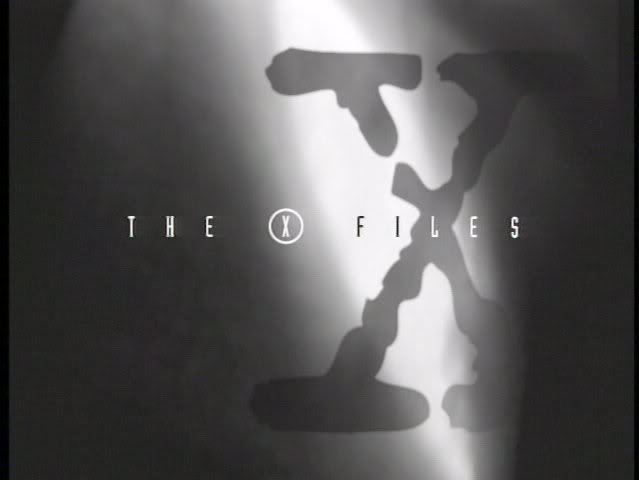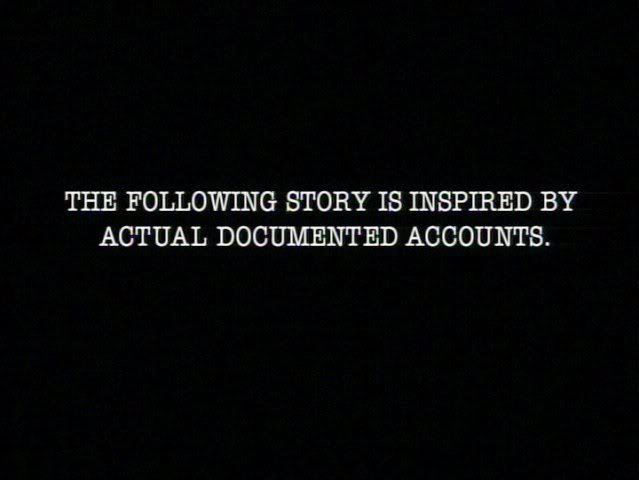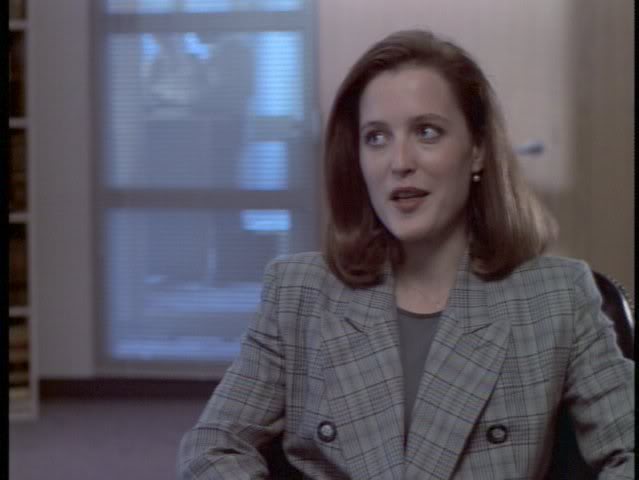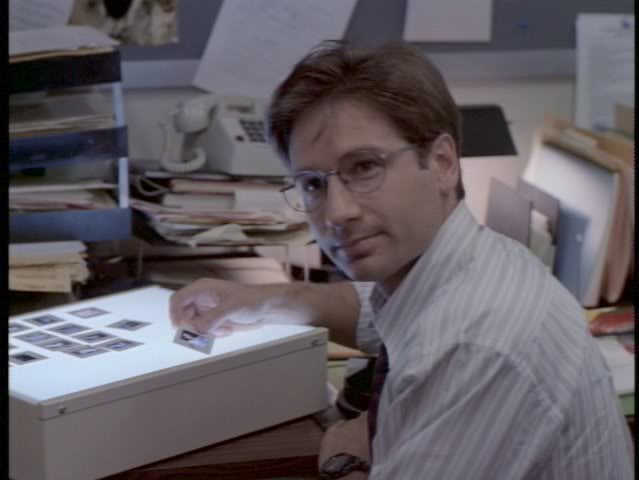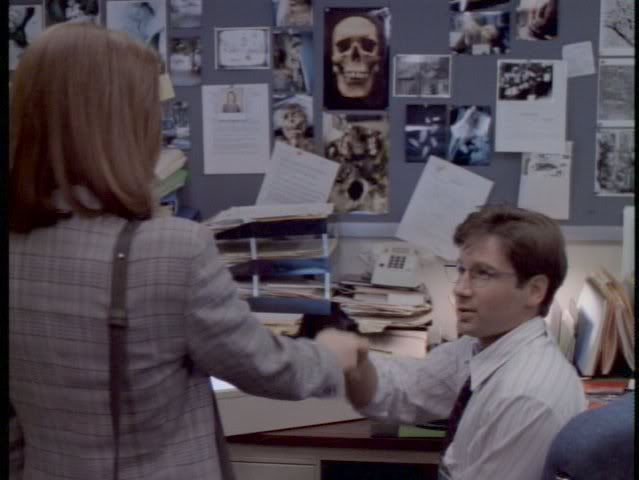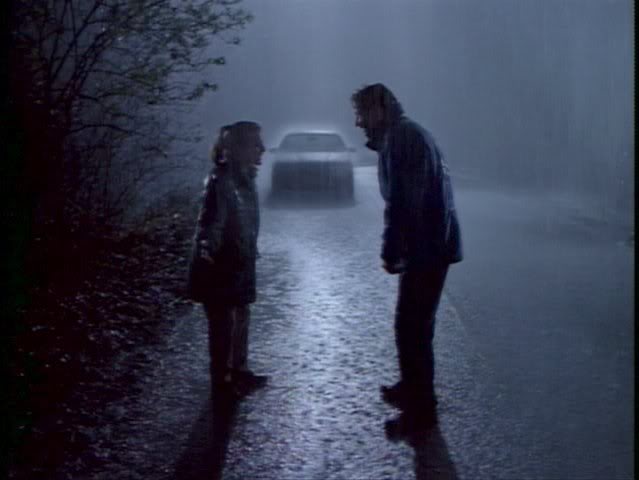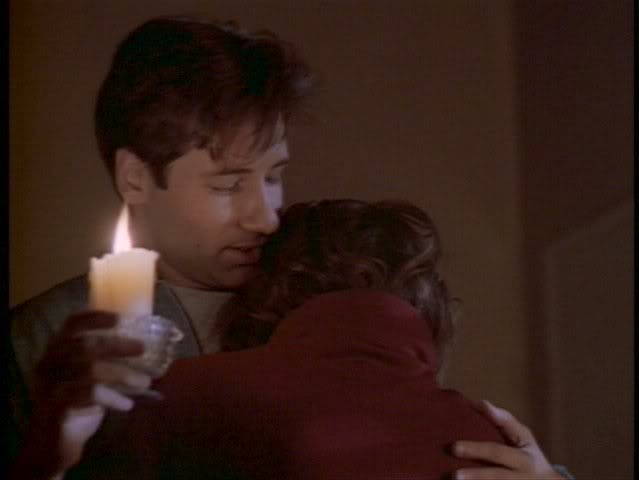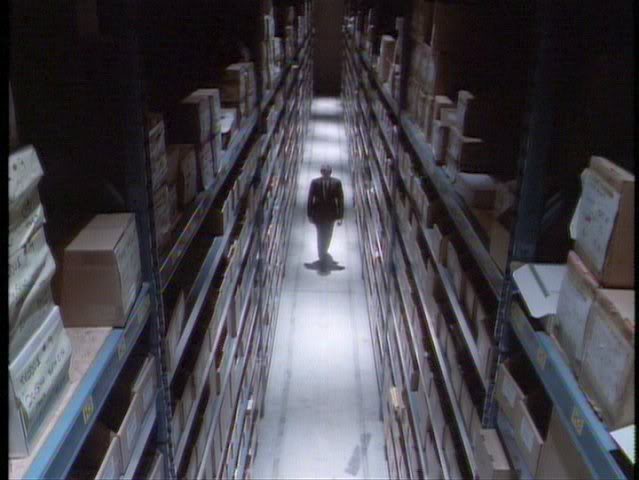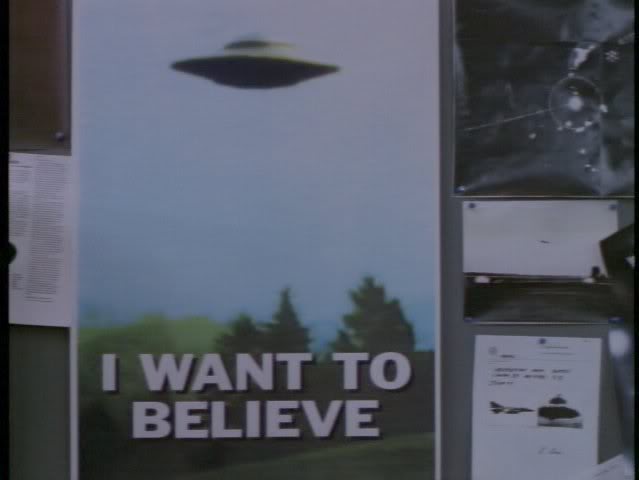09.10.06
Where Were You on September 10, 1993?
At 9 p.m. eastern time on that Friday night, you might have started your weekend by switching to the fledgling Fox network to catch a new show called The X-Files.
A unique entry in primetime television on various levels, the series followed the exploits of two FBI agents, Fox Mulder and Dana Scully, as they investigated cases that dealt with paranormal phenomena. The X-Files had the distinction of being not only one of the few explorations of the macabre to find a regular home on network TV in many years, but it was also a true self-starter -- a show that found its audience without the benefit of having an established hit airing before it.
There was little in Chris Carter's upbringing to suggest the legion of extraterrestrials, demons, and spirits -- not to mention the occasional paranoid conspiracy theory or two capable to making even Oliver Stone blush -- that was apparently percolating inside his head.
Carter was born and raised in Bellflower, California, a non-descript Los Angeles suburban, the son of a construction worker. Carter and his younger brother Craig enjoyed a fairly normal childhood. He grew up with a love of baseball and pitched in Little League. He took up surfing at the age of 12, and his passion for it led him to write for and eventually spend five years editing Surfing magazine after graduating from California State University at Long Beach with a major in journalism in 1979. He also worked as a freelance writer and traveled extensively abroad.
As with most Hollywood success stories, the labyrinthine journey that resulted in The X-Files was almost as twisted as an X-File itself, with about as many different perspectives on exactly how it happened. Carter began dating his wife, Dori Pierson, four years after leaving college. A screenwriter whose credits included the feature Big Business, Pierson prodded Carter to write movies, and his work caught the attention of Jeffrey Katzenberg, then Disney Studios chairman, who signed Carter to a writing deal There he was put to work writing such Disney TV movies as B.R.A.T. Patrol and Meet the Munceys.
A pickup softball game in Brentwood, California, provided another inning in Carter's career, since that was where the writer met Brandon Tartikoff, then the president of NBC Entertainment. "Chris was the left-handed power-hitting rightfielder on the team," said Tartikoff, who found out after a game that Carter was a writer. After Tartikoff had a chance to read some of Carter's work, he brought him to NBC where Carter developed a number of pilot shows, including a female detective yarn called Cameo by Night starring Sela Ward, and Brand New Life, a sort of updated Brady Bunch.
Tartikoff was in a serious car accident that required months of recovery, and shortly thereafter he left NBC to become chairman of Paramount Pictures. He tried to bring Carter there, but it wasn't to be. Still, Tartikoff wasn't Carter's only admirer. His writing also impressed Peter Roth, the president of Stephen J. Cannell Productions. He read a pilot script that Carter wrote entitled Cool Culture -- a show inspired by the youth culture Carter witnessed living at the beach and working for Surfing magazine. The script never went anywhere, but Roth loved Carter's feel for dialogue; and kept Carter in mind when he moved from Cannell to Twentieth Century Fox as president of TV production. In 1992, he took a chance by signing a few relatively unknown producers, among them Carter. They were to develop programs through Twentieth Century Fox Television, a sister arm of Fox Broadcasting within entertainment mogul Rupert Murdoch's studio empire.
Shortly after he came to the studio, Carter had lunch with Roth and mentioned that he'd always wanted to do his take on The Night Stalker, producing something truly frightening for television.
Roth expressed some enthusiasm for that notion, indicating that vampires, which were at the heart of the original movie, might indeed be hot given that a big-screen incarnation of Interview with the Vampire was in the works at that time. Carter wasn't interested in vampires per se, saying his vision had more to do with UFOs and more broadly, the paranormal.
After his meeting with Roth, Carter began to refine his premise, trying to figure out "how not to fall into the big pit that The Night Stalker had fallen into" by running out of steam after one season. He knew that he needed a concept that would provide a more hospitable series framework, something sustainable week after week without stretching the parameters of credibility. The Oscar-winning movie The Silence of the Lambs had just been released, which helped spur the idea of using the FBI as a natural means of entry into this world of the paranormal.
With some further modification and research, Carter had his foundation -- namely, that there must be somebody at the FBI investigating unexplained cases. The show, then, would focus on two FBI agents -- one a believer, the other a skeptic -- investigating cases involving paranormal phenomena. One of the main characters would be driven by a personal experience, having witnessed the abduction of his younger sister when he was 12 years old.
The cherry on top for Carter came when a friend who happened to be a research psychiatrist at Yale showed him a Roper Organization survey saying, essentially, that three percent of the U.S. population believes they've been abducted by aliens. Whether those results were valid or not, Carter felt he'd found a potential well-spring of interest in a topic getting short shrift elsewhere.
Small personal details found their way into The X-Files as Carter began shaping the material. The believer, Fox Mulder, was given the maiden name of Carter's mother and first name of a kid he'd known growing up. His partner, the more doubtful Dana Scully, took her moniker from Los Angeles Dodgers broadcaster Vin Scully -- who to any young Southern California baseball fan owning a radio was, as Carter put it only half-jokingly, "the voice of God."
Delving into his own skeptical nature, Carter also planted the seeds for what was to become an integral part of the show -- namely, the assumption that there are forces at work within the government seeking to keep this information from coming to light. Specifically, Scully is essentially directed at first to do what she can to undermine Mulder's findings, and possible evidence of UFOs is hidden away in a Pentagon storage room in the pilot's concluding sequence.
Though he was still a teenager at the time of the Watergate hearings, those events clearly left their mark on Carter, who admitted that coverage of the scandal and President Richard Nixon's subsequent resignation was "the most formative event of my youth." Small wonder that he named a key character Deep Throat after the Watergate reporters' shadowy source, and that he came up with lines like "Trust no one" ("My personal philosophy," he said), "I want to believe," "Deny everything," and "The truth is out there" -- the last in that series a double entendre, he suggests, nicely summing up the atmosphere he wanted the show to convey.
The next step involved selling the concept to a network. Executives at Fox Broadcasting, Twentieth's sister company, were Carter's first and, as it turned out, only stop. Roth and the producer met with Bob Greenblatt, Fox's vice president of dramatic series development, who in early 1995 was promoted to oversee the creation of all primetime series at the network.
"I was initially very nervous about the paranormal phenomena stuff," Greenblatt admitted, fearing that such material could look "really corny and cheesy" if it wasn't executed properly. Greenblatt didn't want to end up with a rehash of The Night Stalker -- prone to the same plot limitations -- or something tongue-in-cheek. According to Greenblatt, those initial meetings in the late summer and fall of 1992 were somewhat awkward because The X-Files concept was so difficult to pitch verbally. Roth also remembered Carter being somewhat uncomfortable during the pitching phase, as network and studio executives second-guessed the elements within each show. "Chris and I mixed it up pretty good during that process," Roth added. In addition, Greenblatt worried that his boss, Fox Entertainment Group president Peter Chernin, wouldn't go for a show whose premise involved chasing around in search of extraterrestrials.
"I pitched it once and they said, 'No thank you,'" Carter recalled. "I pitched it again and they finally said 'Okay, we'll buy it, leave us alone.'" Despite his doubts, Greenblatt remembered being struck by Carter's obvious talent and passion for the project. The seminal moment occurred for him when the producer turned in a single-spaced, 18-page outline for the pilot blocking out the scenes and even containing lines of dialogue. "It really is what the pilot episode became," said Carter, who still has that treatment.
"Everyone thought this has got to be as real as possible," said Carter. "No one could understand why someone would want to watch a show if it weren't true." As a concession, the Pilot carried a written statement saying that the story was "inspired by actual documented events" -- the only episode to do so.
Most jostling over elements in the show followed. In November 1992, Greenblatt got a new boss when Chernin was promoted to a job running Fox's movie division and his chief lieutenant, Sandy Grushow, was named to replace him. Fox had ordered a script at that point and Greenblatt was firmly committed to the project, but it would be largely up to Grushow whether the network would ante up to produce a pilot.
Grushow, who left Fox in September 1994, remembered Greenblatt coming to his house over Thanksgiving weekend in 1992 to run down the scripts he'd bought as candidates for the coming eason -- at that point a full 10 months away. One of them was The X-Files, and he took note when Greenblatt told him that the creator, Chris Carter, was "a Brandon Tartikoff protége" -- good credentials, he thought, for a relatively unknown producer.
"I remember thinking to myself that it was a distinctive type of show, that there wasn't anything else on the air quite like it," said Grushow, who poured over stacks of scripts that weekend. "Distinctive" was also the watchword at Fox, which was using the programming equivalent of guerilla warfare tactics -- trying to counter the more established networks with programs not readily found on their airwaves. Grushow decided to give the go-ahead for the pilot, thinking the show might be a good substitute for the reality series Sightings, which also dealt with UFOs and drew a fairly sizable audience but, by the nature of its format, didn't inspire much enthusiasm among advertisers.
With the pilot ordered, the parties had to settle on casting the leads. As was usually the case, various actors read for each part before the field was whittled down to a few contenders. The decision on Mulder came down to David Duchovny (at the time best known for his stint on Twin Peaks) and one other actor. The alternative was "cooler, and a little more tortured" than Duchovny's take on the character, said Carter. Though Fox officials maintained Duchovny pretty much walked away with the role thanks to his wry sense of humor, which came across in the audition and meeting, Carter said he had to steer them a bit toward his preferred choice.
The X-Files was the only pilot script that Duchvony's manager sent him that year. "I read it, and I thought it was a really good story and that UFOs would get boring after three or four episodes," said Duchovny. "I thought I could go to Vancouver for a month and get paid, and then go on and do my next movie."
A more vigorous wrestling match ensued over Scully. Greenblatt said he knew the character "had to be real" on the heels of Jodie Foster's Oscar-winning performance in The Silence of the Lambs, though those associated with the show still insist there was some muttering from within Fox about finding more of a bombshell -- someone who could hold their own in a fashion show with the cast of Melrose Place. If some Fox officials were looking for the equivalent of Pamela Anderson, however, Carter and Twentieth Television's casting chief, Randy Stone, immediately locked in on Gillian Anderson -- a 24-year-old actress virtually unknown in television other than a guest shot on Fox's short-lived series Class of '96.
"When she came into the room, I just knew she was Scully," Carter said. "I just felt it ... She had an intensity about her; intensity always translates across the screen."
Anderson had her own misgivings about doing television but circumstances had softened her reluctance -- having found film work scarce and her bank account dwindling. The actress hoped a few weeks working on a television show might increase her profile, at least, when she came calling for film roles. What Anderson didn't fully realize was the battle taking place behind the scenes over casting her. Carter maintained that he "had to put my career on the line to put Gillian in the show," but took great delight in "proving the naysayers wrong."
Doubts about Anderson didn't end with her casting. Even as footage started to come back from the pilot filming there was, Roth said, "tremendous negativity toward Gillian" from some quarters -- questions as to whether the character was too cold, or if she was likable enough. Another point of contention involved the nature of the relationship between the leads. Carter insisted that they stay clearly platonic despite those urging him to establish more sexual chemistry, and he eventually won that battle in spite of the pressures from the network.
Logistically, Ten Thirteen Productions and Twentieth TV had planned to produce the show in Los Angeles but couldn't find an appropriate outdoor setting for the pilot's alien abduction plot in the Pacific Northwest. The decision was ultimately made to "go where the good forests are," Carter said, shifting locations to Vancouver -- a city that not only offered monetary savings compared to L.A., but which had the advantage of being able to visually approximately almost any city in North America.
Filming itself was no picnic. Because The X-Files got a late start, and more than 20 pilots were being shot in the Vancouver area in the crunch to get the series hopefuls ready to be considered for the fall primetime lineups, the producers didn't get their first choice in terms of hiring for technical positions, which added to the burden of working in what was then a totally foreign environment. In addition, Carter said, there was "some animosity and antagonism between the crew and some of the producers and the director," the latter being Robert Mandel, a friend of Carter's whom he personally recruited to helm the pilot.
Filming began in March 1993, and the first scene -- shot at the Canadian Broadcasting Corporation -- perhaps appropriately involved the sequence where Dana Scully first meets Fox Mulder, venturing into the bowels of the FBI building that he called home to the FBI's most unwanted. The actors had only been able to rehearse at a table reading, not on the set, and Carter knew those first dailies would be closely scrutinized -- in part because of the haggling that preceded Anderson's casting, in part because the nature of the actors' relationship would be central to whether the show itself would work.
The actors had an immediate rapport, despite difficult conditions. Duchovny was taken with Anderson's grit and determination as they filmed one scene in the face of freezing rain; and Anderson joked that Duchovny had a pretty good rapport with most women. Other technical hurdles faced the production; and when it was all over, director Mandel recalled saying that they'd all see each other again when the show became a series, a comment few took very seriously based on the survival rates of most pilots.
The two-week shoot completed, Fox received the pilot that spring just as dozens of other contenders streamed in hoping for a slot on the primetime lineup -- an annual filtering process not unlike salmon heading upstream, creating enormous odds against any show making it on air, much less becoming a success. Postproduction, which included adding music, sound effects, and editing, wasn't completed until early May, only a matter of days before Fox would officially see the hour and set its fall schedule.
About creating the show's theme music, Mark Snow said: "Chris sent over tons of CDs and he would say, 'And this CD I like the drums and this I like the vocal sound and the guitar thing that repeats here is really cool, and blah, blah, blah.' So I’m getting a little dizzy and thinking, wow, what am I going to do? I put my elbow down on the keyboard and there was some echo machine that had this repeated sound to it: da-da-da-da-…, you know, and that became the accompaniment."
During the screening for Fox executives, there was some nervous laughter in the room and Greenblatt thought the show was dead. The conclusion, however, was met with applause -- a rare occurrence as bleary-eyed network staffers sift through dozens of series candidates. "It screened gangbusters," said Grushow. Top Fox officials, among them Murdoch and chairman Lucie Salhany, who also became a strong advocate of the show -- subsequently called Roth to congratulate him on the program.
In spite of the positive feedback, The X-Files was still the *other* drama Fox ordered that spring, with most of the network's hopes and attention focused on a Western entitled The Adventures of Brisco County, Jr. "The assumption was that Brisco was going to lead the way and The X-Files was going to benefit from the very significant lead-in that Brisco would provide for it." As a result, Fox decided to place The X-Files on its fall primetime lineup airing in the hour after Brisco County, hoping the Western would lasso viewers and deliver them to its companion.
Before the season began, Fox officials were clearly more effusive in praising Brisco County and its star, Bruce Campbell, than The X-Files. In that regard, when Grushow commented that he'd "eat my desk" if Campbell didn't become a star, Duchovny's competitive spirit was piqued, feeling like The X-Files was being dismissed and slighted. Carter remembered Duchovny returning from an event where Grushow made those comments and joking about serving him the condiments for that meal. The attitude, Duchovny said, was that Fox was touting the other show and treating their entry as an afterthought -- as if it were "and, oh yeah, there's this other little show called The X-Files."
Early reviews proved largely favorable, although some critics and reporters didn't know what to make of the macabre series and, moreover, gave it a slim chance of surviving long enough to close many cases. In its fall TV preview edition, influential Entertainment Weekly magazine, listing synopses of new series, wrote of The X-Files, "We know -- this show's a goner," but then during the show's second season, featured the series on the cover.
After more than a year of planning and production, viewers received their first look at The X-Files on September 10, 1993, beginning with a story about a group of teenagers abducted in the Pacific Northwest. The hour closed with Mulder calling Scully after the evidence relating to their case had disappeared, saying he'll see her the next day. As the description in Carter's original script eloquently put it, "... there's no doubt from the unsettled tone in her voice that it is much more than work. It will become the defining event of her life. Nothing that comes after now -- religion, motherhood, anything -- will not pass through the filter of this experience."
The inherent poetry of those lines notwithstanding, the real test was ultimately commerce -- or more specifically, how many eyeballs the show could attract. The series garnered an encouraging 7.9 Nielsen rating (which translated to just over 7.4 million homes) and 15 percent of the primetime audience. That was more than satisfactory for Fox, which at the time faced a competitive handicap versus the major networks in terms of its distribution system and had little audience profile on Friday nights. "The premiere numbers got everybody's attention," Grushow said, though studio insiders said that the show's promotion time still lagged well behind Brisco County at that point and, indeed, for several months to follow.
Ratings gradually slipped as Brisco -- which also bounded out of the starting gate -- slowed from a gallop to barely a trot. The X-Files began to show signs of life on its own in January and February, gradually climbing from April into May and scoring its best rating of the season -- an 8.8 rating for its first-season finale.
Grushow pointed out that when Fox saw how the audience responded to the show, the network quickly increased promotion. The executive said he told the advertising department to push the "thrills and chills aspect of the show," out of which grew the first-season promotional line, "Don't watch it alone."
The X-Files finished its first season ranked 113 out of 132 primetime series broadcast in terms of the number of homes tuning in; however, the network took into account that the show aired on Friday nights when fewer people in general, and younger viewers in particular, are apt to be home watching television. The show also routinely surpassed ratings for the show that preceded it. As word-of-mouth spread, The X-Files was also increasingly seen by disproportionate numbers of young, educated viewers -- groups that command a premium when the networks sell time to advertisers. Taking into account all these factors, as well as its own fledgling status, Fox renewed the show for a second season, and more people discovered the series during the summer. Certain episodes drew bigger audiences for repeat airings than their first showing, and that snowball effect was evidence in the second-season premiere: a 10.3 rating and a 17 percent jump over the season one finale.
And the rest, as they say, is history.
What did the 1993 Fall Preview Edition of TV Guide have to say about the new Friday night series The X-Files?
Stars: Pictured David Duchovny, Gillian Anderson.
Premise: The FBI meets The Twilight Zone. Duchovny plays a loner agent who takes on cases for which there are no rational explanations -- except aliens invading Earth, maybe. And Anderson plays a skeptical young agent who's sent to spy on him for their bosses back at headquarters.
Strong Point: Like The FBI and the best of the true-crime series, these tales are told with an absolutely straight face and told well.
Weak Point: If you can overlook a credibility gap the size of the Milky Way -- and many viewers will overlook it -- the show is actually well-done. Whether you believe these stories or not, they're first-rate entertainment.
Bottom Line: Better than it sounds -- a well-produced, suspenseful mystery series that draws you in and keeps you hooked.
The X-Files' competition on Friday nights: Step by Step and Hangin' With Mr. Cooper on ABC; Good Advice and Bob on CBS; and the NBC Friday Night Mystery on NBC.
Some other series that premiered in the fall of 1993: Lois & Clark: The New Adventures of Superman, seaQuest DSV, Living Single, Dave's World, NYPD Blue, The Nanny, Grace Under Fire, Boy Meets World, and Frasier.
A few soon-to-be-well-known actors appeared in short-lived series in 1993: Ron Eldard in Bakersfield, P.D., Courtney Cox in The Trouble with Larry, and Ben Affleck in Against the Grain.
Thanks to chrisnu and about dd for the pics used above.
Hard to believe it's 13 years later! Hope you enjoyed this walk down memory lane!
Polly
